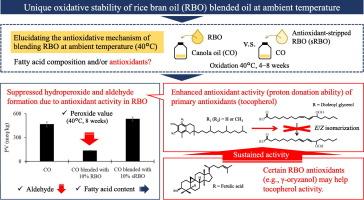Elucidating the antioxidative mechanisms by blending rice bran oil with canola oil at ambient temperature
IF 8
1区 农林科学
Q1 FOOD SCIENCE & TECHNOLOGY
引用次数: 0
Abstract
Oil blending is a useful way to modify the unique properties of vegetable oils such as oxidative stability. Rice bran oil (RBO) has excellent oxidative stability due to its fatty acid (FA) composition with relatively more saturated FA and less polyunsaturated FA along with a variety of antioxidants and is therefore expected to be used in blend with other vegetable oils. However, there are limited studies demonstrating the benefits of blending RBO. Our earlier study revealed that blending RBO, even with a small amount, can significantly suppress volatile aldehydes (propanal and acrolein) during oxidation, especially at ambient temperature (around 40 °C). In this study, the potential antioxidative effect and mechanism responsible for the prior condition were investigated using canola oils (CO) blended with two types of RBO (original form and antioxidant-stripped), focusing on oxidation products (aldehyde and hydroperoxide), unoxidized FAs, and antioxidants (tocopherol (Toc), tocotrienol (T3), and γ-oryzanol (OZ)). The results showed that aldehydes, hydroperoxides (peroxide value), and FA degradation were significantly suppressed in CO blended with 10 % RBO but not with 10 % antioxidant-stripped RBO during oxidation at 40 °C. The analysis of triacylglycerol hydroperoxide isomers and antioxidant profile revealed that blending RBO could preserve the antioxidant activity (proton donation ability) and maintain Toc. This might be attributed to the maintained antioxidant activity of primary antioxidants (Toc), possibly sustained by other certain antioxidants in RBO (e.g., OZ). Consequently, RBO-blended oil exhibited prolonged antioxidant activity, especially at ambient temperature, demonstrating a promising practice to extend shelf-life across multiple applications.

研究了米糠油与菜籽油常温共混的抗氧化机理
混合油是一种有效的方法来改变植物油的独特性质,如氧化稳定性。由于米糠油的脂肪酸组成中饱和脂肪酸较多,多不饱和脂肪酸较少,而且含有多种抗氧化剂,因此米糠油具有良好的氧化稳定性,有望与其他植物油混合使用。然而,有有限的研究证明混合RBO的好处。我们早期的研究表明,混合RBO,即使是少量的,也可以在氧化过程中显著抑制挥发性醛(丙醛和丙烯醛),特别是在室温(约40°C)下。在本研究中,研究了菜籽油(CO)与两种类型的RBO(原始形式和抗氧化剂剥离)的混合,重点研究了氧化产物(醛和过氧化氢)、未氧化的FAs和抗氧化剂(生育酚(Toc)、生育三烯醇(T3)和γ-米zanol (OZ))的潜在抗氧化效果和机制。结果表明,在40°C氧化过程中,10% RBO对醛、氢过氧化物(过氧化值)和FA的降解有显著抑制作用,而10% RBO对醛、氢过氧化物(过氧化值)和FA的降解无显著抑制作用。对三酰基甘油氢过氧化物异构体的分析和抗氧化谱分析表明,混合RBO可以保持抗氧化活性(质子给能)和维持Toc。这可能是由于初级抗氧化剂(Toc)保持抗氧化活性,可能是由RBO中的其他某些抗氧化剂(如OZ)维持的。因此,rbo -调和油表现出较长的抗氧化活性,特别是在室温下,这表明了在多种应用中延长保质期的前景。
本文章由计算机程序翻译,如有差异,请以英文原文为准。
求助全文
约1分钟内获得全文
求助全文
来源期刊

Food Research International
工程技术-食品科技
CiteScore
12.50
自引率
7.40%
发文量
1183
审稿时长
79 days
期刊介绍:
Food Research International serves as a rapid dissemination platform for significant and impactful research in food science, technology, engineering, and nutrition. The journal focuses on publishing novel, high-quality, and high-impact review papers, original research papers, and letters to the editors across various disciplines in the science and technology of food. Additionally, it follows a policy of publishing special issues on topical and emergent subjects in food research or related areas. Selected, peer-reviewed papers from scientific meetings, workshops, and conferences on the science, technology, and engineering of foods are also featured in special issues.
 求助内容:
求助内容: 应助结果提醒方式:
应助结果提醒方式:


